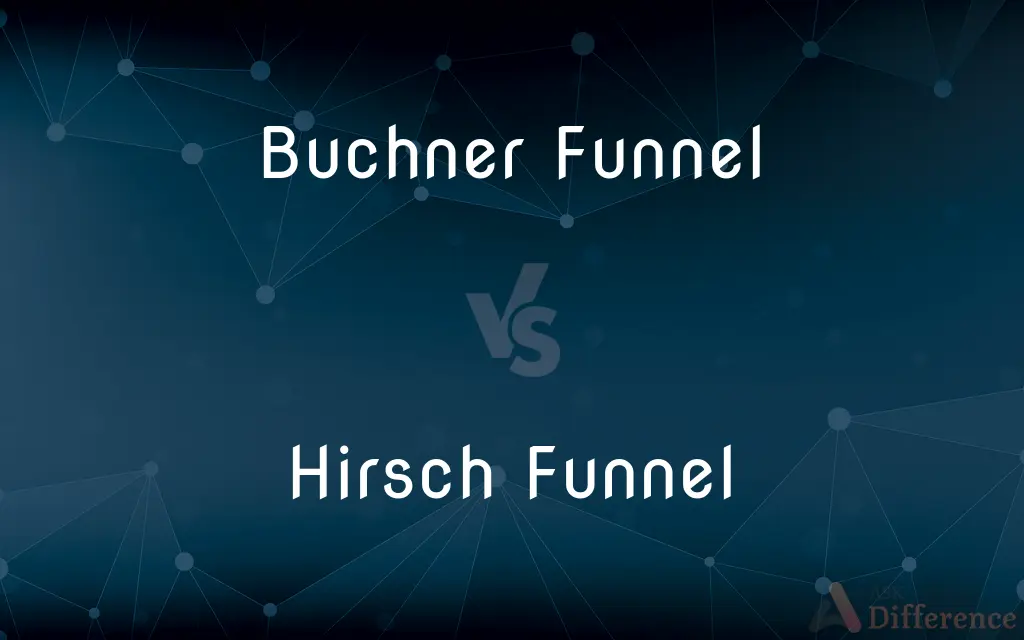Buchner Funnel vs. Hirsch Funnel — What's the Difference?
Edited by Tayyaba Rehman — By Urooj Arif — Published on February 22, 2024
A Buchner funnel is used for vacuum filtration in larger scale applications, featuring a flat perforated base, while a Hirsch funnel, designed for smaller quantities, has a conical shape with a perforated base.

Difference Between Buchner Funnel and Hirsch Funnel
Table of Contents
ADVERTISEMENT
Key Differences
Buchner funnels are widely used in laboratories for separating solids from liquids through vacuum filtration. They have a flat, perforated base that supports the filter paper and are typically made from porcelain or plastic. Their design is conducive to handling larger volumes of liquid, making them suitable for bulk filtration tasks.
Hirsch funnels, on the other hand, share a similar purpose but differ in size and design. They are smaller with a conical or slightly angled shape, which makes them perfect for filtering small volumes of liquid quickly. The smaller size also allows for finer control over the filtration process, ideal for delicate laboratory tasks.
Both funnels are used in conjunction with a vacuum system to speed up the filtration process, while the Buchner funnel's larger surface area accommodates more filter paper and, consequently, more precipitate. This design aspect makes it the preferred choice for tasks requiring the filtration of large volumes or large amounts of solid material.
The Hirsch funnel, with its compact size, is particularly useful in organic chemistry and biochemistry laboratories where only small quantities of a substance are typically handled. Its design is optimized for rapid filtration, making it indispensable for tasks requiring efficiency and precision on a smaller scale.
Despite their differences, both Buchner and Hirsch funnels are essential tools in chemical laboratories. The choice between them often depends on the specific requirements of the experiment, such as the volume of liquid to be filtered and the size of the particles in the precipitate.
ADVERTISEMENT
Comparison Chart
Design
Flat, perforated plate
Conical or slightly angled
Size
Larger, suitable for bulk filtration
Smaller, designed for quick, small-scale filtration
Volume Handling
Capable of filtering larger volumes
Suited for small volumes of liquid
Usage
Preferred for large amounts of precipitate
Ideal for rapid filtration of small samples
Material
Commonly made from porcelain or plastic
Often made from porcelain or glass
Compare with Definitions
Buchner Funnel
A flat-bottomed funnel used for vacuum filtration.
The chemist used a Buchner funnel to separate the precipitate from the reaction mixture.
Hirsch Funnel
Suited for filtering small quantities.
Hirsch funnels are perfect for small-scale experiments in the lab.
Buchner Funnel
Commonly made from porcelain.
The porcelain Buchner funnel is durable and resistant to most chemicals.
Hirsch Funnel
Optimized for precision.
The compact design of a Hirsch funnel allows for precise control over the filtration process.
Buchner Funnel
Utilizes vacuum for faster filtration.
Connecting a Buchner funnel to a vacuum pump significantly speeds up the filtration process.
Hirsch Funnel
Often made from glass.
Glass Hirsch funnels are preferred for their chemical inertness and clarity.
Buchner Funnel
Accommodates large filter papers.
A Buchner funnel's wide surface area allows for the use of larger filter papers.
Hirsch Funnel
A small, conical funnel for quick filtration.
The researcher used a Hirsch funnel for the rapid filtration of her sample.
Buchner Funnel
Designed for bulk filtration tasks.
Buchner funnels are essential in labs for processing large volumes of liquids.
Hirsch Funnel
Features a finer pore size.
The fine pore size of a Hirsch funnel makes it ideal for delicate filtrations.
Common Curiosities
Can a Buchner funnel be used for small-scale filtrations?
While possible, a Buchner funnel is less efficient for small-scale filtrations compared to a Hirsch funnel due to its size.
Are Buchner and Hirsch funnels resistant to chemicals?
Yes, they are made from materials like porcelain and glass, which are generally chemical-resistant.
What materials are Buchner and Hirsch funnels made of?
They are typically made from porcelain, glass, or plastic, depending on the specific laboratory requirements.
Can filter paper size affect the choice between Buchner and Hirsch funnels?
Yes, larger filter papers fit better in Buchner funnels, while smaller ones are suited for Hirsch funnels.
Can both funnels be used in organic chemistry?
Yes, both are used in organic chemistry, with the choice depending on the scale of the filtration.
Is training required to use these funnels?
Basic laboratory training is sufficient to use Buchner and Hirsch funnels effectively.
Why is vacuum used in filtration with these funnels?
Vacuum enhances filtration efficiency by pulling the liquid through the filter paper faster.
What is a Buchner funnel used for?
A Buchner funnel is used for vacuum filtration of large volumes, separating solids from liquids efficiently.
How does a Hirsch funnel differ from a Buchner funnel?
A Hirsch funnel is smaller, with a conical shape, designed for quick filtration of small quantities, unlike the larger, flat-bottomed Buchner funnel.
Is a Hirsch funnel suitable for large volumes?
No, a Hirsch funnel is designed for small volumes and might not be practical for large-scale filtrations.
How do you clean a Buchner or Hirsch funnel?
They can be cleaned with appropriate solvents, followed by rinsing with water, and drying.
Are there any safety concerns when using these funnels with a vacuum?
Proper setup and caution are required to prevent implosion, especially with glass apparatus.
Do Buchner and Hirsch funnels have any limitations?
Their effectiveness is limited by the filter paper's pore size and the vacuum system's strength.
How does the filtration speed compare between the two funnels?
Hirsch funnels typically offer quicker filtration for small volumes due to their smaller size and design.
Can these funnels be used with all types of filter paper?
Yes, but the filter paper size and porosity should match the funnel design and filtration requirements.
Share Your Discovery

Previous Comparison
Belt Transect vs. Line Transect
Next Comparison
AR Financing vs. PO FinancingAuthor Spotlight
Written by
Urooj ArifUrooj is a skilled content writer at Ask Difference, known for her exceptional ability to simplify complex topics into engaging and informative content. With a passion for research and a flair for clear, concise writing, she consistently delivers articles that resonate with our diverse audience.
Edited by
Tayyaba RehmanTayyaba Rehman is a distinguished writer, currently serving as a primary contributor to askdifference.com. As a researcher in semantics and etymology, Tayyaba's passion for the complexity of languages and their distinctions has found a perfect home on the platform. Tayyaba delves into the intricacies of language, distinguishing between commonly confused words and phrases, thereby providing clarity for readers worldwide.
















































